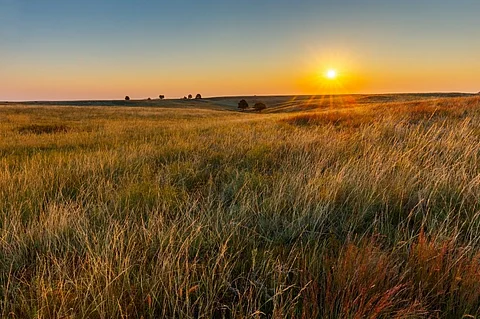

In a span of one year, an area of Great Plains grasslands bigger than the state of Delaware in United States was lost, according to a new report by World Wildlife Fund (WWF). In total, 32 million acres have been ploughed up since 2012, primarily for row crop agriculture, the report found.
The report analysed the rate of grassland ploughing across the US and Canadian portions of the Great Plains. An estimated 1.6 million acres of grasslands across the US and Canadian Great Plains were destroyed in 2021, said WWF’s 2023 Plowprint Report. Over 400,000 acres in the Northern Great Plains region of the ecosystem were ploughed over in just 2021.
On the bright side, nearly 377 million acres of grass cover remain across the Great Plains, the vast majority of which is privately owned. Policy, the report urged, is the best way to ensure that the Great Plains grasslands continue to exist and benefit both people and wildlife.
The majority of the grasslands with the best agricultural soils were ploughed up decades ago. The remaining intact grasslands are not always as productive for row-crop farming. Many of the converted acres are actually used for non-food crops like biofuels.
The most common crops on acres converted in 2021 were wheat (27 per cent), corn (18 per cent) and soy (17 per cent). When it comes to the Northern Great Plains, the ratio of wheat is 40 per cent, corn is 18 per cent and soy is 10 per cent.
In 2021, total agricultural trade in the United States reached new highs. Agricultural exports were valued at $177 billion in 2021, an 18 per cent increase over 2020. However, agricultural expansion has often resulted in unintended consequences, like the significant and ongoing ploughing up and destruction of the Great Plains.
Grasslands support agriculture, food security, rural communities, and the economy by performing critical environmental functions such as water supply, soil health, climate resilience, biodiversity and carbon sequestration.
The loss of grasslands affects all, not just the people living in those areas. When grasslands are ploughed, increasing amounts of carbon are released into the atmosphere, increasing the likelihood of frequent and intense droughts. Aquifers get affected as they are not replenished due to lost infiltration and increased run-off from ploughed fields. Many of the plants and animals of the Great Plains are unable to adapt to a rapidly changing environment.
Across the Northern Great Plains, about 70 per cent of private lands and 97 per cent of public lands (most of which cannot be ploughed) have remained intact. Native Nations have a positive impact on conservation, with 80 per cent of tribal lands remaining intact grasslands.
“Let’s stop ploughing grasslands; just allow them to keep storing and sequestering carbon — and providing irreplaceable habitat for wildlife and pollinators — as they have done for millennia,” said Martha Kauffman, vice president for WWF’s Northern Great Plains programme.
It is hoped that policies like the reauthorisation of the next Farm Bill and the impending North American Grasslands Conservation Act, which, if passed, will allocate resources and develop strategies that can support the livelihoods of people across the Great Plains.